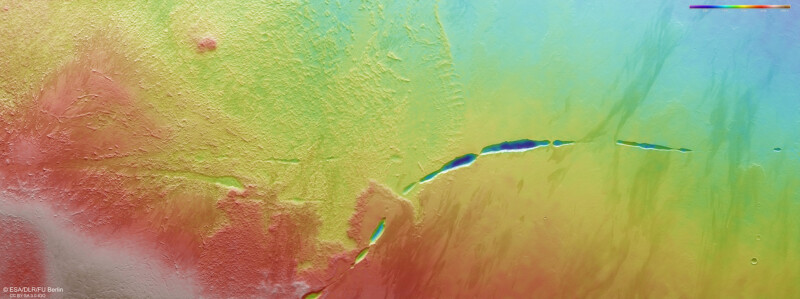![]()
An enormous Grand Canyon-sized scar on the surface of Mars has been pictured in never-before-seen detail.
The European Space Agency’s (ESA) Mars Express satellite captured the image at the end of last year.
The striking scar even has a name, the Aganippe Fossa, and is roughly 375 miles long (600 kilometers) and is known as a “grabben” which is a ditch-like groove with steep walls on either side.
Live Science notes that, from above, the grabben appears incomplete with breaks in the groove but it is thought the be a single structure stretching about 100 miles longer than the Grand Canyon.
But the Aganippe Fossa is thousands of miles shorter than Mars’s Valles Marineris — the biggest canyon in the solar system, which runs for a length of 2,500 miles (4,000 kilometers).
Aganippe Fossa is located in the Elysium Planitia region of Mars — on the lower flanks of one of Mars’s largest volcanoes, Arsian Mons, which stands roughly 12.4 miles high (20 kilometers) with a huge diameter of 270 miles (425 kilometers).
Mars Express’s High-Resolution Stereo Camera (HRSC) captured two different kinds of terrain: so-called hummocky terrain, which comprises many irregularly shaped mounds and valleys all clustered together, and lobate terrain, which is formed of gently sloping cliffs and rocky debris.

The ESA says it is still unsure of how and when Aganippe Fossa came to be or how old it is. But the space agency says “it seems likely that it was formed as magma rising underneath the colossal mass of the Tharsis volcanoes caused Mars’s crust to stretch and crack.”
NASA previously estimated that Arsian Mons, the volcano above the crack, stopped erupting around 50 million years ago. However, there is evidence of Martian volcanic eruption as recently as 50,000 years ago.
The European Space Agency’s Mars Express is a long-running and highly successful mission designed to explore Mars from orbit.
Launched on June 2, 2003, it was originally planned for a two-year mission but it has been extended multiple times and continues to operate, providing valuable data about Mars.
Image credits: ESA/DLR/FU Berlin.
